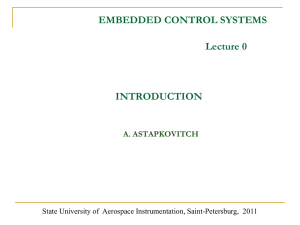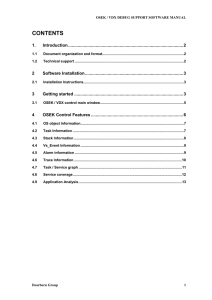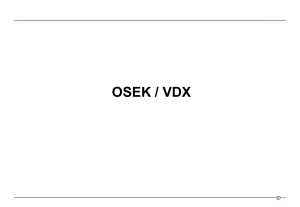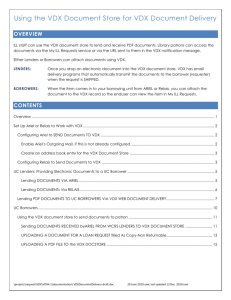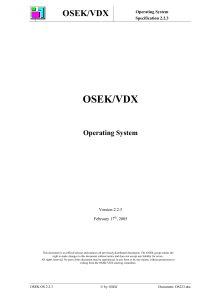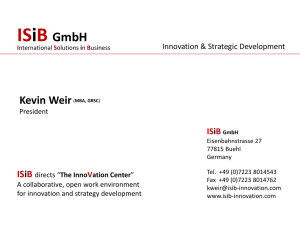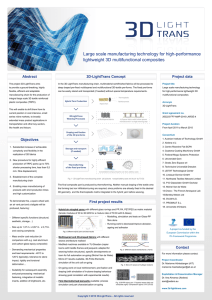CSE666_OSEK_Khasim
advertisement
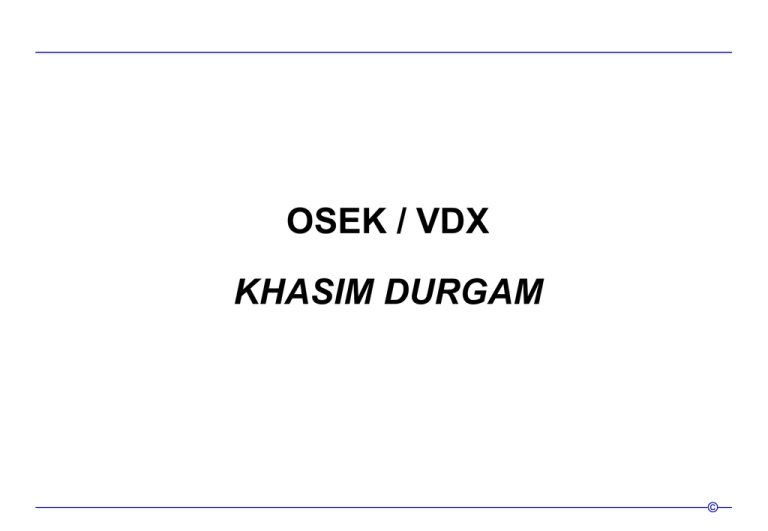
OSEK / VDX KHASIM DURGAM © OSEK / VDX > Agenda OSEK/VDX Standard - Overview OSEK/VDX Operating System – Overview (Task Concept, Scheduler, Events) © OSEK/VDX > What is OSEK/VDX? • Joint project of the European automotive industry Target: Define an industry standard for an open-ended architecture for distributed control units in vehicles. • Founded 1993 OSEK: Offene Systeme und deren Schnittstellen für die Elektronik im Kraftfahrzeug (“Open Systems and the Corresponding Interfaces for Automotive Electronics”) VDX: Vehicle Distributed eXecutive Joined OSEK in 1994 OSEK/VDX • On the way to a worldwide ISO standard ISO 17356: Open interfaces for embedded automotive applications. • Web site http://www.osek-vdx.org © OSEK/VDX > Who is OSEK/VDX? • Steering Committee (initial partners) Decision level (ex. ISO standardization), Meeting every 3 months © OSEK/VDX > Who is OSEK/VDX? • Technical Committee (Associated partners to actively co-operate) Adam OpelAG BMW AG DaimlerChrysler AG FIAT- Centro Ricerche Ford Europe GM Europe GmbH Porsche AG PSA Renault Volkswagen AG Volvo Car Corporation Blaupunkt, Borg Instruments GmbH Continental Teves Cummins Engine Company Delco Electronics Denso Hella KG LucasVarity Magneti Marelli Philips Car Systems Robert Bosch GmbH Sagem Electronic Division SiemensVDO Automotive AG TEMIC UTA - United Technologies Automotive Valeo Electronics Visteon Accelerated Technology Inc. ACTIA AFT GmbH Ashling ATM Computer GmbH C&C Electronics Cambridge Consultants EDS Epsilon GmbH ETAS GmbH & Co KG FZI Greenhills Grupo Antolin Hewlett Packard France Hitachi Micro Systems Europe Ltd. Hitex IBM Deutschland Entwicklung GmbH Infineon INRIA Integrated Systems Inc. IRISA IIIT - University of Karlsruhe Lauterbach Metrowerks Mecel Motorola National Semiconductor NEC Electronics GmbH Noral NRTA Softing GmbH ST Mircroelectronics Stenkil Systems AB Sysgo Real-Time Solutions GmbH TECSI Telelogic GmbH Texas Instruments Thomson-CSF Detexis Trialog Vector Informatik Wind River Systems 3Soft GmbH © OSEK/VDX > OSEK Specifications OSEK OS – serves as a basis for the controlled real-time execution of concurrent applications OSEK OIL – OIL provides a possibility to configure an OSEK/VDX application inside a particular CPU OSEK COM / NM – provides interfaces and protocols for the transfer of data within vehicle networks © OSEK/VDX > Goals & Motivations • Definition of standardized interfaces & protocols (HW & Network independent) Portability, Reusability & Extendibility of SW (through different HW platforms & different applications) Possible "co-habitation" of software from different suppliers Independence regarding a particular implementation • Definition of configurable & scalable functionalities Optimal adjustment of the architecture to a particular context (i.e. same OSEK/VDX interfaces, but different implementations, depending on the hardware architecture and the performance required) Quality improvement Savings in costs and development time © OSEK/VDX > Automotive Embedded Control Software > OSEK/VDX Architecture Electronic Control Unit Embedded Control Software OSEK/VDX OS Function D OSEK/VDX NM Function C Function B IO Actuators SW Function A Sensors OSEK/VDX COM System Bus (e.g. CAN) © OSEK/VDX > OSEK COM Architecture OSEK OS (Operating system) Application SW OSEK COM Interaction layer OSEK NM Network Layer Data link layer Bus communication HW © OSEK/VDX > Goals & Motivations > Reusability HW Platform A HW Platform B OSEK/VDX OS OSEK/VDX NM OSEK/VDX OS Application OSEK/VDX NM OSEK/VDX COM OIL Application OSEK/VDX COM OIL Bus protocol x Bus protocol y © OSEK/VDX > Goals & Motivations > Distributed functions HW Platform HW Platform OSEK / VDX OSEK/VDX OS OSEK / VDX NM A B HW Platform OSEK/VDX OS A OSEK/VDX COM OSEK / VDX NM OSEK/VDX OS B OSEK/VDX COM C NM OSEK/VDX COM HW Platform OSEK OSEK/VDX COM / VDX C NM OSEK/VDX OS © OSEK/VDX Operating System > Overview ISR COUNTER ALARM TASK EVENT MESSAGE RESOURCE HOOK - Single processor operating system Implementations available for 8/16/32 bit µC - Minimum ROM, RAM and CPU time consumption Statically defined resources (tasks, events, alarms, ...) Different levels of functionality (conformance classes) - Standardized operating system behavior and interfaces for the application Services defined according to the ISO/ANSI-C syntax Independent from a specific µC © OSEK/VDX Operating System > Conformance Classes Four conformance classes in the one standard – provides convenient groups of features to ease understanding – enables partial implementations – scalability BCC: Basic tasks ECC: Extended tasks Level 1: One task per priority, one activation per task Level 2: More than one task per priority and more than one activation per task Overheads ECC2 ECC1 BCC2 BCC1 Features © OSEK/VDX Operating System > Task management Basic tasks only release the processor if – they terminate, the OSEK OS switches to a higher priority task (preemption) or an interrupt occurs Extended tasks – can also wait on events (WaitEvent API call) Wait Waiting Running Preempt Release Start Ready Terminate Suspended Activate © OSEK/VDX Operating System > Scheduler Scheduler •The scheduler decides on the basis of the task priority which is the next of the ready tasks to be transferred into the running state. • A preempted task is considered to be the first (oldest) task in the ready list of its current priority. • A task being released from the waiting state is treated like the last (newest) task in the ready queue of its priority. © OSEK/VDX Operating System > Scheduler The fundamental steps to determine the next task to be processed are: • The scheduler searches for all tasks in the ready/running state. • From the set of tasks in the ready/running state, the scheduler determines the set of tasks with the highest priority. • Within the set of tasks in the ready/running state and of highest priority, the scheduler finds the oldest task. © OSEK/VDX Operating System > Preemptive & NonPreemptive Scheduling Non- Preemptive Scheduling Preemptive Scheduling © OSEK/VDX Operating System > Scheduling Policy Mixed preemptive scheduling – Policy depends on the preemption property of the running task • If running task is non-preemptable then non-preemptive scheduling is performed • If running task is preemptable then preemptive scheduling is performed Which to use? – Non-preemption makes sense when execution time of a task is short (same order as task switching overhead), when RAM need to be conserved (no context save required) and when task must not be preempted to provide atomic activity © OSEK/VDX Operating System > Interrupt Processing Two interrupt service routine categories – Category 1: • ISR does not use OS services • ISR executes above the priority level of the scheduler • No additional interrupt latency due to the OS – Category 2: • ISR can use OS services, e.g. activate tasks, etc. • ISR executes under the control of the scheduler • OS imposes some additional latency to set up the ISR environment © OSEK/VDX Operating System > Messages, Events Event mechanism gives a means of synchronisation for extended tasks – Each extended task is associated with one or more events – An extended task may wait for an event with which it is associated – Any task or category 2 ISR may set an event • This moves the waiting extended task from the waiting state to the ready state • Depending on the scheduling policy and the extended tasks priority level it will then move into the running state – An extended task may then clear the events with which it is associated © OSEK/VDX Operating System > Resource management Resource management is used to co-ordinate concurrent access to shared resource, e.g. memory, hardware, etc. Resource management ensures – two tasks (or interrupts) cannot occupy the same resource at the same time, i.e. provides atomic access to critical sections Tasks (and interrupts) make a GetResource call to indicate they are going to use a shared resource Tasks (and interrupts make a ReleaseResource call to indicate they have finished with a shared resource © OSEK/VDX Operating System > Resource management OSEK requires the use of the priority ceiling protocol for resource management: – – – – Priority inversion minimised Deadlock cannot occur Access to resource never results in a waiting state Can be analysed to enable real-time performance to be guaranteed S1 ceiling = high © OSEK/VDX Operating System > Priority Inversion © OSEK/VDX Operating System > Deadlock © OSEK/VDX Operating System > Solution for Priority Inversion & Deadlock 1. 2. 3. 4. 5. 6. Task T0 has the highest, and task T4 the lowest priority. Task T1 and task T4 access the same standard resource. Task T4 get the resource and raise its priority to the ceiling priority. Task T0 preempts task T4 because its has a higher priority. When task T0 finishes, task T4 continues to run and release the standard resource. Task T1 which is ready to run get the resource and preempts task T4. Task T4 is put into ready state. Task T1 finishes and release resource. Since task T2 and T3 are ready, task T4 must wait for task T2 and T3 to complete before it can continues its tasks. © OSEK/VDX Operating System > Alarms Provides support for processing recurring events – The recurring events (sources) are registered by implementation specific counters – Based on the counters the OSEK OS provides alarm mechanisms to the application developer Counters provide a counter value measured in ‘ticks’ Alarms expire when a predefined counter value is reached, it can then: – Activate a task – Set an event © Counter Source Counter: 15 11 12 13 14 Alarm: 13 (Activate T1) Alarm: 15 (Set Event E1) ... T1 Activated! E1 Set! Standardised OSEK OS Application View Implementation Specific OSEK/VDX Operating System > Alarms © OSEK/VDX Operating System > Hook Routines StartupHook • Called at OS startup, interrupt disabled • Can be used for initialization purpose ShutdownHook • Called at OS shutdown, interrupt disabled • Can be used for epilogue purpose PreTaskHook • Called when a task enters the running state of a task • Not to be used due to CPU time consumption PostTaskHook • Called when a task exits the running state of a task • Not to be used due to CPU time consumption ©
